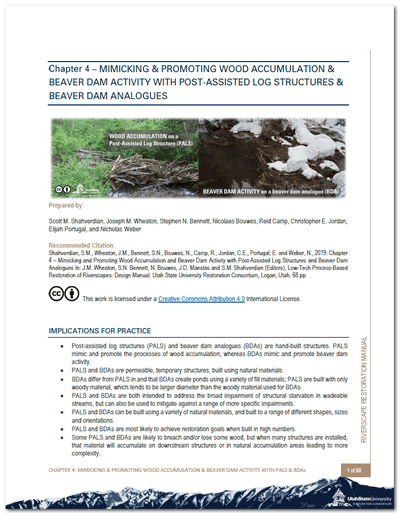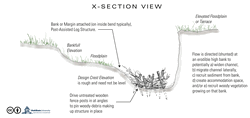Chapter 4: Mimicking and Promoting Wood Accumulation and Beaver Dam Activity with Post-Assisted Log Structures and Beaver Dam Analogues
 The fourth chapter is meant to be the authoritative reference on two low-tech restoration techniques, which are lacking guidelines in the literature: post-assisted log structures (PALS) & beaver dam analogues (BDAs). The chapter focuses on helping readers understand what PALS & BDAs are, how they are used in low-tech restoration design, and a specific focus on the processes intially mimicked, later promoted, and that eventually become self-sustatining; namely wood accumulation and beaver dam activity.
The fourth chapter is meant to be the authoritative reference on two low-tech restoration techniques, which are lacking guidelines in the literature: post-assisted log structures (PALS) & beaver dam analogues (BDAs). The chapter focuses on helping readers understand what PALS & BDAs are, how they are used in low-tech restoration design, and a specific focus on the processes intially mimicked, later promoted, and that eventually become self-sustatining; namely wood accumulation and beaver dam activity.
Chapter 4 also has appendices on:
- Appendix A. Freqently Asked Questions About PALS and BDAs
- Appendix B: Low-Tech Process-Based Restoration Semantics
- Appendix C: Recent History of Beaver Dam Analogues
- Appendix D: Typical Schematics and General Suggestions for Placement and Construction of PALS
- Appendix E: Typical Schematics and General Suggestions for Placement and Construction of BDAs
 Full PDF available for free at ResearchGate, but ResearchGate requires a free account.
Full PDF available for free at ResearchGate, but ResearchGate requires a free account.
Implications for Practice

- Post-assisted log structures (PALS) and beaver dam analogues (BDAs) are hand-built structures. PALS mimic and promote the processes of wood accumulation; whereas BDAs mimic and promote beaver dam activity.
- PALS and BDAs are permeable, temporary structures, built using natural materials.
- BDAs differ from PALS in and that BDAs create ponds using a variety of fill materials; PALS are built with only woody material, which tends to be larger diameter than the woody material used for BDAs.

- PALS and BDAs are both intended to address the broad impairment of structural starvation in wadeable streams, but can also be used to mitigate against a range of more specific impairments.
- PALS and BDAs can be built using a variety of natural materials, and built to a range of different shapes, sizes and orientations.
- PALS and BDAs are most likely to achieve restoration goals when built in high numbers.
- Some PALS and BDAs are likely to breach and/or lose some wood, but when many structures are installed, that material will accumulate on downstream structures or in natural accumulation areas leading to more complexity.
Recommended Citation
- Shahverdian, S.M., Wheaton, J.M., Bennett, S.N., Bouwes, N., Camp, R., Jordan, C.E., Portugal, E. and Weber, N. 2019. Chapter 4 – Mimicking and Promoting Wood Accumulation and Beaver Dam Activity with Post-Assisted Log Structures and Beaver Dam Analogues. In: J.M. Wheaton, S.N. Bennett, N. Bouwes, J.D. Maestas and S.M. Shahverdian (Editors), Low-Tech Process-Based Restoration of Riverscapes: Design Manual. Utah State University Wheaton Restoration Consortium, Logan, Utah. 66 pp. DOI 10.13140/RG.2.2.22526.64324
Related Resources
Chapter Four Figures
All original figures downloadable and citeable now with DOI: 10.6084/m9.figshare.14445519.v1
Appendix C
All figures downloadable and citeable now with DOI: 10.6084/m9.figshare.14445540
Appendix D - Typical Schematics and General Suggestions for Placement and Construction of PALS
All figures downloadable and citeable now with DOI: 10.6084/m9.figshare.14445564.v1
Appendix E - Typical Schematics and General Suggestions for Placement and Construction of BDAs
All figures downloadable and citeable now with DOI: 10.6084/m9.figshare.14445567.v1



 Beaver Dam Analogue Recipes
Beaver Dam Analogue Recipes  Post-Assisted Log Structure Recipes
Post-Assisted Log Structure Recipes